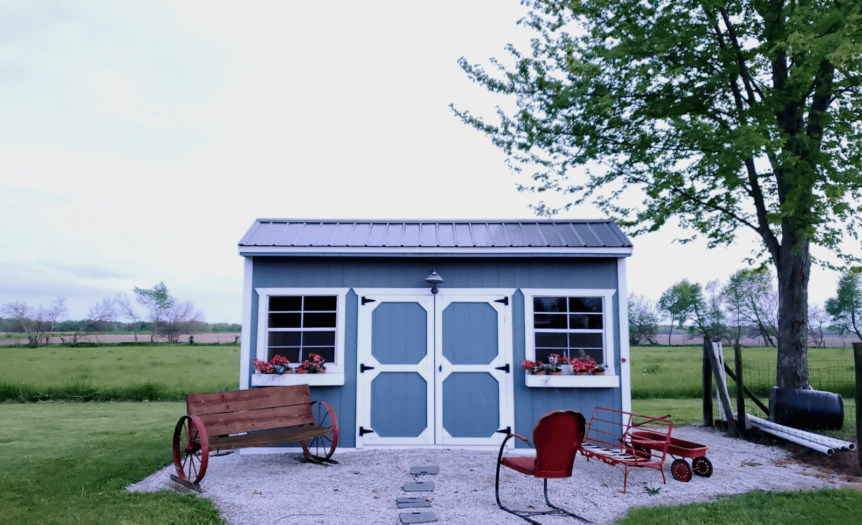Shingling your garden shed offers both practical and aesthetic benefits. It protects your shed from the elements while enhancing its visual appeal. While it may seem intimidating, it’s surprisingly manageable with the right approach.
Materials and Tools You’ll Need
Before you begin, prepare the necessary materials and tools. Having everything ready will save you time and ensure a smooth process. Here’s what you’ll need:
- Roofing shingles
- Roofing nails
- Hammer or nail gun
- Utility knife
- Roofing felt or underlayment
- Chalk line
- Measuring tape
- Ladder
- Roofing cement
- Tarp (optional for debris)
Guide to Roof Shingling
Follow this step-by-step guide to get the job done effectively.
Step 1: Inspect and Prepare the Roof Deck
Start by inspecting your shed’s roof deck to ensure it is in good condition. The roof deck should be flat, solid, and free from any rot, holes, or water damage. If you see any issues, repair them before proceeding to ensure a strong foundation for the shingles.
Next, clean the roof surface thoroughly. Remove any debris, nails, or protruding objects. Make sure the deck is dry before continuing.
Step 2: Install Roofing Felt or Underlayment
Installing roofing felt or underlayment is crucial because it provides another layer of protection against moisture and weather. Start by rolling out the felt from the bottom edge of the roof. Overlap each layer by 2 to 4 inches and secure it with roofing nails. Use the chalk line to ensure straight lines, keeping the underlayment uniform across the roof.

Cover the entire roof with the underlayment, including valleys and ridges, to create a waterproof barrier beneath the shingles, ensuring extra durability against leaks.
Step 3: Install Starter Shingles
Starter shingles are placed along the roof’s edge and serve as the foundation for the rest of the shingles. Cut the tabs off a few shingles using a utility knife. Place these starter strips along the roof’s eave, overhanging the edge slightly to help water runoff. Secure them with roofing nails, ensuring they are evenly spaced and level.
Step 4: Lay the First Row of Shingles
Now that the starter shingles are in place, it’s time to begin laying the first row of full shingles. Start from the bottom left corner of the roof and work your way across. Align the first shingle with the edge of the starter strip, ensuring it overhangs slightly. Secure it with roofing nails, typically placing one near each corner of the shingle, about 1 inch from the edges.
Work your way across the roof, overlapping the shingles as you go. Most shingles have a guideline printed on them to show the overlap required.
Step 5: Continue Laying Rows of Shingles
Once the first row is complete, begin the second row by cutting half a tab off the first shingle. This staggered arrangement ensures that the seams between shingles don’t line up, which could create weak points where water can seep through. Continue laying shingles row by row, working your way up the roof. Ensure each row is aligned correctly and staggered for optimal protection.
Step 6: Shingle the Ridge Cap
The ridge cap, located at the peak of the roof, needs special attention. Cut the shingles into smaller, uniform pieces, typically about 12 inches long, to cover the ridge. Begin at the end of the ridge, laying each piece so it overlaps the previous one. Nail each piece securely, driving the nails into both sides of the ridge.
Step 7: Clean Up and Inspect
After the shingle installation, inspect your work. Check for loose nails or missed spots where shingles didn’t overlap correctly. Apply roofing cement to any exposed nails or problem areas for extra security. Seal the edges properly to prevent water from seeping in.

Finally, clean up the work area. Collect any debris, leftover shingles, and tools. Dispose of any old shingles and clear any nails or hazards from the ground around the shed. If you used a tarp to catch debris, fold it up carefully and dispose of the waste.
Enjoy Your Finished Garden Shed!
With the project completed, your garden shed is now protected and ready to withstand the elements for years. Shingling a garden shed is a rewarding DIY project that enhances the shed’s durability and aesthetic appeal. Taking the time to follow each step carefully ensures that the roof will last longer and protect your shed’s contents from rain, snow, and wind.
Don’t forget to get roofing quotes for free from reputable suppliers. The shingles should serve you well for 20-30 years if properly maintained. Inspect the roof annually to catch any potential problems early, such as loose shingles or wear and tear, to maintain the roof’s integrity.







